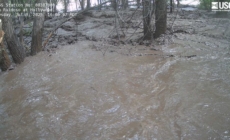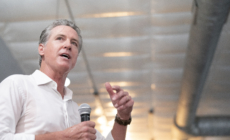-
Bibi’s Empty Victory Lap - 22 mins ago
-
New Mexico Flash Flooding: House Seen Swept Away in Roaring Waters - 30 mins ago
-
Lakers’ Deandre Ayton Doesn’t Hold Back About Luka Doncic - about 1 hour ago
-
Wildfire on Edge of Marseille Injures More Than 100, Officials Say - about 1 hour ago
-
How to Buy Kevin Durant Houston Rockets Jersey: Shop KD NBA Gear - 2 hours ago
-
Wildfires Scar Syria Anew - 2 hours ago
-
Gavin Newsom’s Reaction as Top Democrat Hints at Governor’s 2028 Run - 2 hours ago
-
After Texas Flooding, Questions About FEMA’s Role and Fate Under Trump - 3 hours ago
-
Dog dragged behind car in SoCal streets. Driver calls it an accident, official says - 3 hours ago
-
Ex-NFL QB Delivered Strong Message to Commanders Amid Drama - 3 hours ago
Opinion | Dairy Workers Are the Most Vulnerable Population to Bird Flu
H5N1 is in a better position than ever to move between species and spill over aggressively into humans: This bird flu virus is now thought to have been spreading among dairy cows for many months, and federal regulators have found viral fragments circulating widely in the commercial milk supply chain across the United States (though live virus has not been found).
The one person we know of so far who has tested positive for infection (a mild case) was a Texas dairy worker. Agricultural workers have always been an underprotected population for zoonotic diseases, including influenza viruses of animal origin. When it comes to H5N1, the dairy work force — which includes on-farm workers and milkers, people working in the milk processing plants and in slaughterhouses, truck drivers and other professionals who come onto farms — is among those with the highest exposure.
Not only do we owe these at-risk workers better protection, but we also must do a much better job — immediately — of monitoring and testing them to ensure the virus doesn’t spread beyond our control. Otherwise, we might not find out about a significant outbreak in humans until it’s too late.
So far, bird flu testing of this cohort has been woefully inadequate. Testing is usually under the purview of state authorities following federal Centers for Disease Control and Prevention guidelines. Tests are recommended for symptomatic workers. The exact number of dairy workers and other people who have so far been tested for H5N1 is not publicly available at the federal level. There is no excuse to continue only limited testing of this vulnerable population. Any serious surveillance efforts of H5N1 demand that the country do better to ensure proper testing and health care is provided to these workers now, lest we risk being caught flat-footed by a new pandemic so soon after Covid.
This is especially important for a work force whose broader social and economic circumstances may discourage them from seeking out timely testing and treatment. A majority of hired farmworkers in the United States are from Mexico and Central American countries; many lack authorization to work here legally. Undocumented workers may be worried about public health reporting systems putting them at risk for immigration enforcement or preventing future chances of gaining a visa or permanent residency status.
Communication is a further concern. According to a 2019 survey, over half of U.S. dairies have employees whose native language is not English; these individuals most often speak Spanish, but some speak only Indigenous languages such as K’iche’ or Nahuatl. Many workers have limited literacy and education that dairy farms accommodate with pictorial signage and visual training materials. Any effective bird flu education campaign would have to be similarly tailored to these workers’ communication needs — a capacity that not many health departments have.
These workers are further endangered from a public health standpoint thanks to the industry’s low wages and benefits and lack of enforcement for health and safety standards. In 2019, the Center for North American Studies reported an average hourly starting wage of $11.24 for novice dairy workers, and an average hourly wage among all dairy workers of $13.90. It also found that more than 40 percent of U.S. dairy farms do not provide health insurance, and only 47 percent offer paid sick leave. Significant income could be lost while traveling to distant rural health services for an eye infection or flulike symptoms — health conditions that a majority of the work force reasonably brush off. Even worse outcomes may go unreported out of a fear of losing out on work.
Farms across the country also need to make these workers’ day-to-day tasks safer. Some state surveys have shown that many dairy worker respondents lacked personal protective gear such as masks, goggles, gloves and aprons, or were noncompliant in its use despite the risks of infectious disease exposure.
When protected, dairy farm workers can be a force multiplier for surveillance and resilience efforts around emerging disease threats like H5N1. Individuals who work with livestock on a daily basis, given the right training from the U.S. Department of Agriculture or other veterinary professionals, can serve as field-based surveillance teams; their frequent interaction with animals means they are the first to notice abnormalities in demeanor, physical appearance or production of eggs and milk. They can share information among peers and be provided a public platform like ProMED (the International Society for Infectious Diseases’s disease outbreak communication system) for anonymously reporting infectious diseases to local, state or federal public health authorities. The federal government and state officials can increase support of local surveillance programs, and reduce economic barriers for dairy owners who want to provide better access to health care services for employees.
These efforts are about more than just responding to bird flu and preventing a human outbreak. Our agricultural industry will always be on the front lines against zoonotic disease threats. We need to empower it to protect workers from these biological dangers, not just for the workers but for all of us. Providing widespread H5N1 testing now to the dairy work force is a necessary step — but only the first.
Erin M. Sorrell is a senior scholar and associate professor at Johns Hopkins University. Monica Schoch-Spana is a medical anthropologist and a senior scholar and research professor at Johns Hopkins University. Meghan F. Davis is a former dairy veterinarian and is an associate professor at Johns Hopkins University.
The Times is committed to publishing a diversity of letters to the editor. We’d like to hear what you think about this or any of our articles. Here are some tips. And here’s our email: letters@nytimes.com.
Follow the New York Times Opinion section on Facebook, Instagram, TikTok, WhatsApp, X and Threads.



















